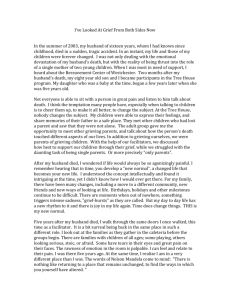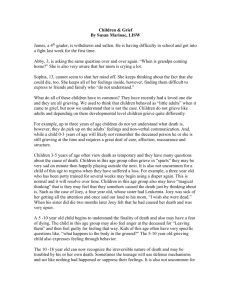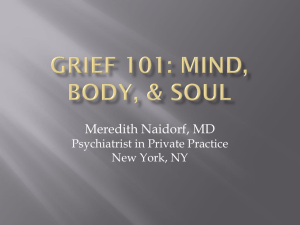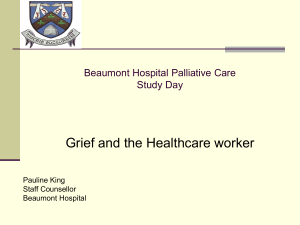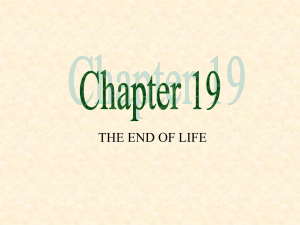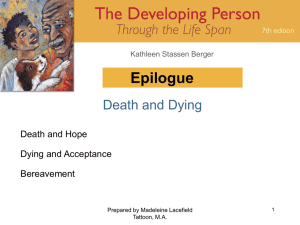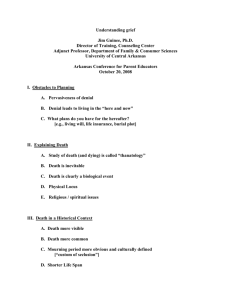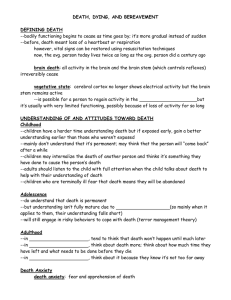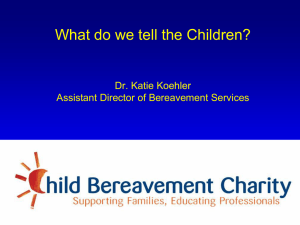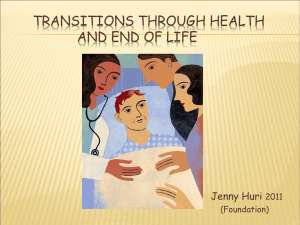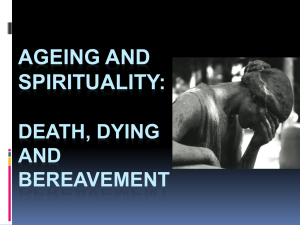End of Life Care
advertisement
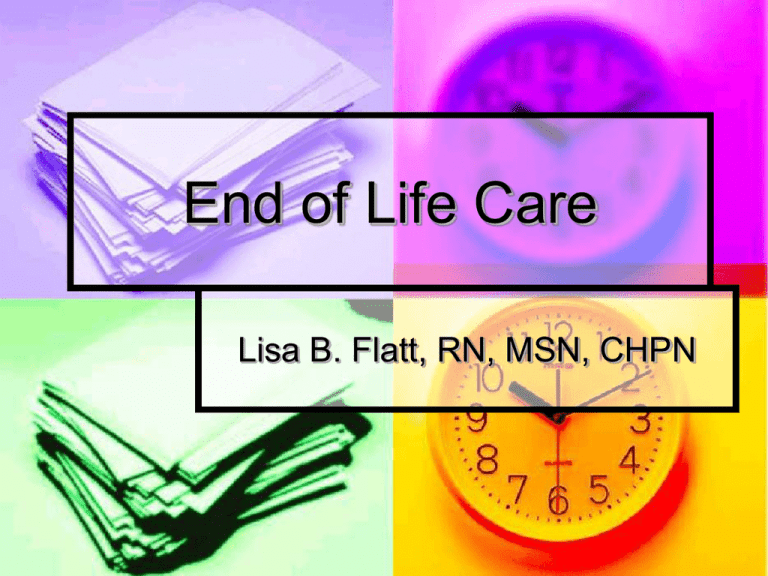
End of Life Care Lisa B. Flatt, RN, MSN, CHPN Objectives Understand palliative care Compare and contrast settings where palliative care and end of life care occur Identify stages of grief, uncomplicated grief and mourning Describe legal, historical, social and cultural aspects of palliative and end of life care Definitions to know Assisted suicide Autonomy Grief, Mourning & bereavement Euthanasia Terminal illness Hospice Medicare hospice benefit Basic Concepts Loss –something/person and be actual or potential no longer with you, valued Sources of Loss – body image, death, loss of independence, brain ability, financial, memory Grief Response Bereavement (subjective) and Mourning (process follows bereavement, resolution of grief) Normal grieving – essential for mental health following a loss, steps are involved, helps you move on S/S of grieving – depression, sadness, isolation, wt loss, sleep disturbances, ETOH, SA, fatigue, N&V, HA, faint, palpitations Variations of grief – anticipated or abbreviated Dysfunctional grief – pathological, unresolved, extended s/s of grief, stuck in a phase Kubler-Ross’s (1969) Stages of Grief Denial – shock, didn’t happen, numb, disbelief Anger – guilt, resentment, sadness Bargaining – pining, searching, yearning Depression – grieving Acceptance - resolution Engel’s (1964)Stages of Grief Shock & disbelief Developing awareness – directed anger, loss becomes real Restitution – dealing with it all, looking more Resolving the loss – memories, talk it out Idealization – ‘the best at…..’ Outcome – acceptance, moving on Sander’s (1998) Five Phases of Bereavement Shock – confused, unreal, disbelief Awareness of loss – conflict, stress, seperation anxiety Conservation/Withdrawal – despair, hopeless, isolation Healing – identity, control Renewal – acceptance, revitalization Influencing factors and grieving Age – younger/children, acceptance as we age, familiar, free from pain and poor quality of life Significance of loss – how close, spouse, parents, pets, kids, relatives Culture – major, beliefs Spiritual belief – influences outcome of death and acceptance Gender – woman disfigured with scar (idealization of beauty), stoic Socioeconomic – affordability of care and funerals Support system - acceptance, after-care Cause of death/loss – traumatic injury, extended illness, unexpected death, suicide, drug OD Death & Dying More accepted with age Develops over time Children – temporary state Adults – frightening Quality of life and lack of it can determine a persons perspective on death Concept of Death and Development Age Attitudes and Beliefs 0 to 5 Reversible; Sleep; Temporary ‘trip’’; immobility & inactivity are part of death; separation forms basis for undstg later 5-9 Death is final; own death avoidable; aggression & violence; wishes/unrelated actions may be responsible 9 - 12 Inevitable end of life; understanding mortality = interest in fear of death or interest in afterlife 12 – 18 Fear lingering death; doesn’t think much about; views in religious/philosophic ways; emotionally difficult to accept; fantasize it can be defied (acting out in reckless behaviors) 18 – 45 Attitude is influences: religious and culture belief system 45 – 65 Accepting of own mortality; peaks of death anxiety; emotional well being = decrease of death anxiety; death of parents and peers occurs 65 + Fear of prolonged illness, death of family and peers; multiple meanings = reunion, free from pain Definitions of Death With life support & medical interventions, in 1968 World Medical Assembly redefined Clinical – absence of apical pulse, respirations and BP Lack of OR NO response to: Eternal stimuli Reflexes Brain waves aeb flat encephalogram Respirations or muscular movement Dying Trajectories (Glaser & Strauss 1965) Death and dying are unique Series of graphs Has limitations to ‘predictions’ Progression may be difficult to predict If someone knows outcome, this may affect trajectory (sense of control over dying process and illness) Types of Trajectories Expected trajectory – short duration, steadily progressing downward (terminal cancer) Unexpected trajectory- episodes of acute deterioration, recovery, decline then unexpected death Lingering/Prolonged – elderly escaping cancer and MOF then die later with dementia, Alzheimers, etc.. Physiologic Needs (pg 104) Maintain airway Pain free Positioning/comfort Pastoral/spiritual care Mouth care ADL’s, brushing hair Impending Death Muscle tone – decreased, relaxed face, swallowing, speaking Circulation – slows down, mottling, cold Respirations – rapid, shallow, noisy, dry, mouth breathing, slows and irregular Sensory impairment Vision- blurred Decreased smell/taste (or hypersensivity) Care Post-Mortem When appropriate, after they are gone and family aware and in agreement Clean, covered Remove tubes and lines Dignity Teeth, eyes closed Rigor mortis Hospice Cecily Saunders, MD founded concept Support and care of person & family Goal: peaceful and dignified death Holistic and interdisciplinary Qualified if MD certifies within the last 6 months of life Where can hospice care occur? Home Facility Hospital ECF Define Palliative Care Relief from symptoms of disease Relief from pain Support to patient and family, coping mechanisms Interdisciplinary team Death not imminent Allow pt and family to live as ‘normally’ as possible The Nursing Process Assessment/Analysis Planning Rationale Factors influencing grief & dying Implementation Evaluation
